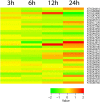Metabolite-Centric Reporter Pathway and Tripartite Network Analysis of Arabidopsi s Under Cold Stress
- PMID: 30258841
- PMCID: PMC6143811
- DOI: 10.3389/fbioe.2018.00121
Metabolite-Centric Reporter Pathway and Tripartite Network Analysis of Arabidopsi s Under Cold Stress
Abstract
The study of plant resistance to cold stress and the metabolic processes underlying its molecular mechanisms benefit crop improvement programs. Here we investigate the effects of cold stress on the metabolic pathways of Arabidopsis when directly inferred at system level from transcriptome data. A metabolite-centric reporter pathway analysis approach enabled the computation of metabolites associated with transcripts at four time points of cold treatment. Tripartite networks of gene-metabolite-pathway connectivity outlined the response of metabolites and pathways to cold stress. Our metabolome-independent analysis revealed stress-associated metabolites in pathway routes of the cold stress response, including amino acid, carbohydrate, lipid, hormone, energy, photosynthesis, and signaling pathways. Cold stress first triggered the mobilization of energy from glycolysis and ethanol degradation to enhance TCA cycle activity via acetyl-CoA. Interestingly, tripartite networks lacked power law behavior and scale free connectivity, favoring modularity. Network rewiring explicitly involved energetics, signal, carbon and redox metabolisms and membrane remodeling.
Keywords: cold stress; microarray; network modularity; pathway analysis; power law; reporter metabolite; reporter pathway.
Figures








Similar articles
-
Multiple Regulatory Networks Are Activated during Cold Stress in Medicago sativa L.Int J Mol Sci. 2018 Oct 15;19(10):3169. doi: 10.3390/ijms19103169. Int J Mol Sci. 2018. PMID: 30326607 Free PMC article.
-
Genes, pathways and transcription factors involved in seedling stage chilling stress tolerance in indica rice through RNA-Seq analysis.BMC Plant Biol. 2019 Aug 14;19(1):352. doi: 10.1186/s12870-019-1922-8. BMC Plant Biol. 2019. PMID: 31412781 Free PMC article.
-
Comparative transcriptome meta-analysis of Arabidopsis thaliana under drought and cold stress.PLoS One. 2018 Sep 7;13(9):e0203266. doi: 10.1371/journal.pone.0203266. eCollection 2018. PLoS One. 2018. PMID: 30192796 Free PMC article.
-
Comparative proteomic and metabolomic analyses reveal mechanisms of improved cold stress tolerance in bermudagrass (Cynodon dactylon (L.) Pers.) by exogenous calcium.J Integr Plant Biol. 2014 Nov;56(11):1064-79. doi: 10.1111/jipb.12167. Epub 2014 Mar 21. J Integr Plant Biol. 2014. PMID: 24428341
-
Rapid transcriptional and metabolic regulation of the deacclimation process in cold acclimated Arabidopsis thaliana.BMC Genomics. 2017 Sep 16;18(1):731. doi: 10.1186/s12864-017-4126-3. BMC Genomics. 2017. PMID: 28915789 Free PMC article.
Cited by
-
Cytokinin and abiotic stress tolerance -What has been accomplished and the way forward?Front Genet. 2022 Aug 9;13:943025. doi: 10.3389/fgene.2022.943025. eCollection 2022. Front Genet. 2022. Retraction in: Front Genet. 2024 Mar 19;15:1399259. doi: 10.3389/fgene.2024.1399259. PMID: 36017502 Free PMC article. Retracted. Review.
-
Research Progress on the Roles of Cytokinin in Plant Response to Stress.Int J Mol Sci. 2020 Sep 8;21(18):6574. doi: 10.3390/ijms21186574. Int J Mol Sci. 2020. PMID: 32911801 Free PMC article. Review.
-
Genome-wide identification, phylogeny, and expression analysis of the bHLH gene family in tobacco (Nicotiana tabacum).Physiol Mol Biol Plants. 2021 Aug;27(8):1747-1764. doi: 10.1007/s12298-021-01042-x. Epub 2021 Aug 7. Physiol Mol Biol Plants. 2021. PMID: 34539114 Free PMC article.
-
Continuous Cropping Inhibits Photosynthesis of Polygonatum odoratum.Plants (Basel). 2023 Sep 25;12(19):3374. doi: 10.3390/plants12193374. Plants (Basel). 2023. PMID: 37836114 Free PMC article.
-
Systematic Multi-Omics Integration (MOI) Approach in Plant Systems Biology.Front Plant Sci. 2020 Jun 26;11:944. doi: 10.3389/fpls.2020.00944. eCollection 2020. Front Plant Sci. 2020. PMID: 32754171 Free PMC article. Review.
References
LinkOut - more resources
Full Text Sources
Other Literature Sources

